“But how do you get enough protein?!”
If you’re vegetarian, vegan, or even just a fan of Meatless Mondays, you’ve probably been asked this question.
Plant-based protein is a hot topic for plant-based eaters or anyone whose dietary choices emphasize plant foods as important components.
Much of the controversy and confusion revolves around getting “enough” protein and choosing the “best” sources.
But there’s no one-size-fits-all approach to plant-based protein. That’s because:
- There are lots of different types of plant-based eaters: vegans, vegetarians, flexitarians, pescatarians, people who are plant-curious or plant-forward… the list goes on.
- Getting “enough” protein is relative. A person’s ideal protein intake depends on their individual body, goals, and preferences.
- The “best” sources of plant-based protein may vary from person to person. Some sources may be higher-quality than others, but intolerances and allergies need to be taken into account, as well as what a person is able to eat on a consistent basis.
In this article, we’ll cover everything you need to know about protein for plant-based eaters, including how to answer the following questions for yourself (or your client):
- Why is protein so important, and how much do you need?
- What are the best sources of plant-based protein?
- What should you do if you’re struggling to meet protein needs on a plant-based diet?
Let’s get started.
(If you want to see the authors discuss this article in even more detail, check out the video below. If not, simply scroll over the video player or click here to jump to the next section.)
PN coach roundtable: Robin Beier talks plant based protein with Ryan Andres and Brian St. Pierre.
++++
Many believe plant-based eaters struggle with protein.
To some degree, that’s true.
Here at Precision Nutrition, we’ve coached over 100,000 people on their eating habits. And every year, we ask thousands of new clients about their biggest nutrition challenges via a questionnaire.
Then, our data wizards analyze the responses to understand the most common nutrition problems.
According to our recent intake data, plant-based eaters were much more likely than non-plant-based eaters to have a lower protein intake.
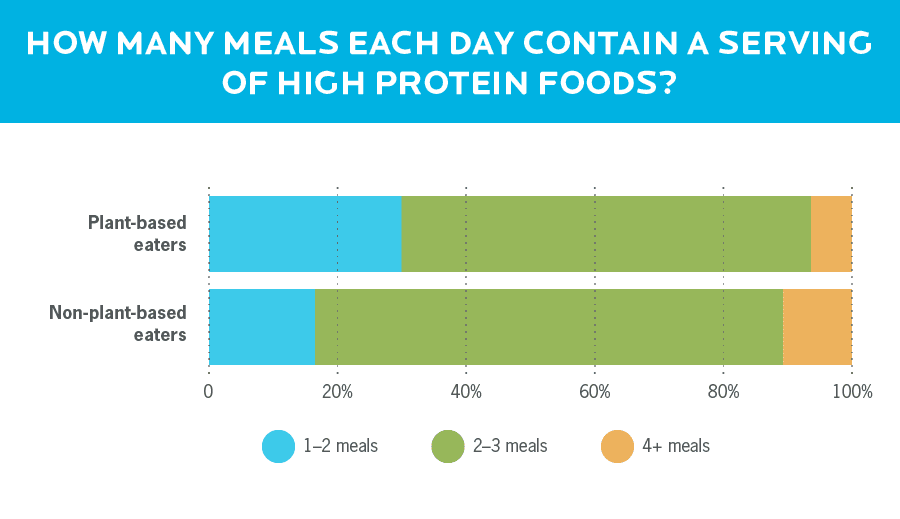
Of course, protein isn’t a problem for all plant-based eaters.
But protein does deserve special attention—no matter what your diet.
Why is protein so important?
We need protein consistently from our diets in order to grow, maintain, and repair our tissues, hormones, and immune system.
Some people may want to eat more or less protein depending on their preferences and goals, but we all need a bare minimum of protein to prevent issues like:
- losing muscle mass (which can cause a drop in your metabolism)
- having skin, hair, and nail problems
- healing more slowly if you get cuts or bruises
- experiencing mood swings
- being more likely to break bones
And unless you have a specific medical reason to keep your protein intake low, most people will benefit from eating more protein.
The specific benefits of a higher-protein diet include:
- Appetite control: Eating a high-protein diet seems to improve satiety.1,2
- Weight and body composition management: Higher protein intakes may help people eat less when they’re trying to lose fat, increase the number of calories burned through digestion (the thermic effect of food), and retain muscle during fat loss.3
- Muscle growth or maintenance: Keeping protein levels high, combined with exercise, helps people gain vital muscle mass and hang onto it over time, especially as they age.4,5
- Improved cardiometabolic health: High protein diets can help lower blood pressure, improve glucose regulation and blood cholesterol, and more.6
- Better strength: Higher amounts of protein combined with exercise can also aid in strength gains.7
- Improved immune function: Proteins are the building blocks of antibodies, and serve several functions in the immune system. People who are protein-deficient are more susceptible to viral and bacterial infections.
- Faster recovery: Higher protein intakes help to repair tissue damaged during exercise, as well as after injury.6
Other folks who need more protein than the bare minimum include those who:
- Are pregnant or breastfeeding
- Are growing
- Have a health issue that causes problems with protein absorption
- Are eating a 100 percent plant-based diet. (More on that in a minute.)
The good news?
With a little knowledge and planning, it’s not so hard to meet your protein goals on a plant-based diet. This is true whether you’re just looking to hit the bare minimum or you want to try out a high-protein approach.
How much protein do you need?
Your protein needs depend on a variety of factors including your age, weight, activity level, health status, goals, and more.
The simplest way to find out how much protein you need—no matter your eating style—is to use our Nutrition Calculator. It’ll tell you how much protein to eat in both grams and easy-to-track hand portions, along with a suggested intake of fat, carbs, and veggies.
But if you’re looking for some general guidelines…
- Sedentary people should aim for a bare minimum of 0.8 grams of protein per kilogram of bodyweight per day (Or 0.36 grams per pound.)
- Adults over 65 should aim for 1.2 to 2.0 grams of protein per kilogram of bodyweight per day. (Or 0.55 to 0.91 grams per pound of bodyweight.) New research shows that most older people need more protein than the bare minimum recommendation to slow down muscle loss.8,9
- Athletes and active people should aim for between 1.2 to 2.2 grams of protein per kilogram of bodyweight per day. (Or 0.55 to 1.0 grams per pound of bodyweight.) People who are overweight and obese may want to stick to the lower end of this range, since protein needs are not as high relative to their bodyweight.
- Healthy people who want to change their weight or body composition should strive for 1.6 to 3.3 grams per kilogram of bodyweight. (Or 0.75 to 1.5 grams per pound.) Going above the threshold for active people (2.2 grams of protein per kilogram) may not be necessary, but there’s little evidence it’s harmful. Fun fact: Some overfeeding studies have ventured as high as 4.4 grams/kilogram (or 2 grams/pound), with no ill effects after several months.10
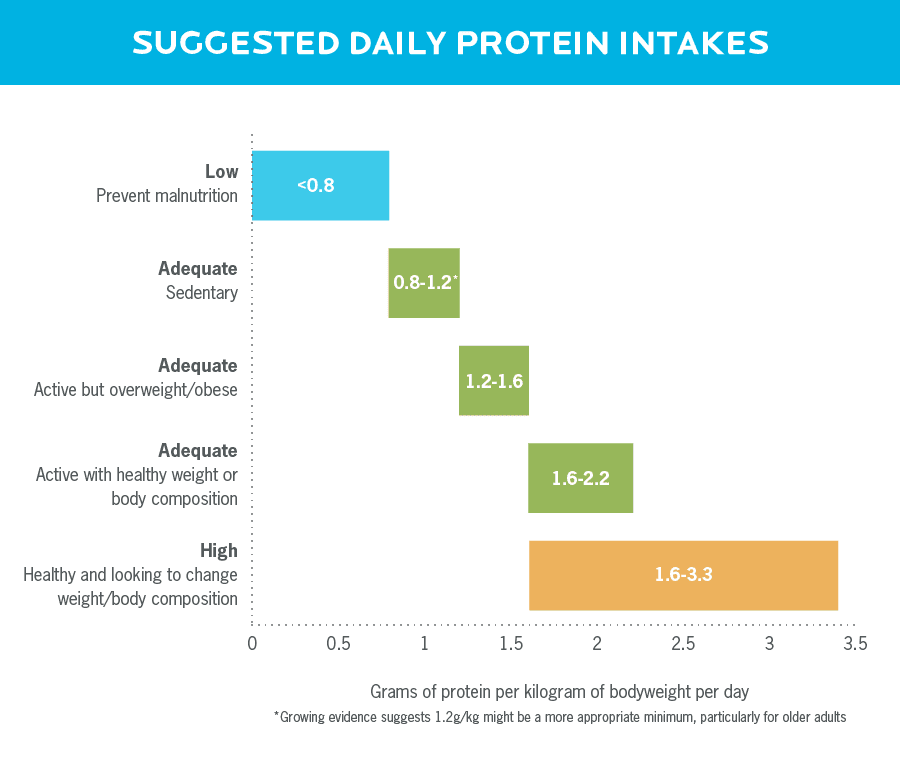
If you’re not sure whether you’re getting enough protein, it may help to experiment with tracking your intake using hand portions or macros for a couple of weeks. Based on what you discover, you can adjust as needed.
Is plant protein as good as animal protein?
Some people wonder if humans need animal protein to be healthy. And the truth is, plant and animal proteins are different in some ways.
All proteins are made up of amino acids, which are sort of like different colored Legos. They can be put together in different ways to serve different purposes in the body.
In all, your body uses 20 different amino acids.
Seven of those are non-essential amino acids. That’s because your body can create them on its own.
There are also four conditionally essential amino acids, which your body can make, but not always. For example, your body might have a harder time making enough of them when you’re sick or after a really tough workout.
The other nine amino acids are known as essential amino acids (EAAs). Your body can’t make these, so you have to get them from food.
This is important, because EAAs play key roles in building and repairing tissue—like muscle—but also in building hormones, enzymes, and neurotransmitters.
Branched-chain amino acids (BCAAs), a subcategory of EAAs, are especially important for their role in muscle protein synthesis.
Muscle protein synthesis is the process your body uses to repair and build muscle after exercise. While muscle protein synthesis is much more complicated than just one amino acid, leucine plays an integral role in triggering the process, which makes it probably the most well-known BCAA.
One thing to keep in mind, though: BCAAs are great, but you still need all of the EAAs to maximize the protein synthesis from your protein source.

The reason all this is relevant: because of how complete and incomplete proteins are often at the center of the plant vs. animal protein discussion.
These terms refer to whether a food has enough of all nine EAAs to meet your protein needs if you only ate that food.
So imagine your sole source of food was eggs. You ate eggs for breakfast, lunch, and dinner. That’s it. Nothing else.
Would subsisting on eggs alone provide all of the EAAs you require? Yes: They’re a complete protein. (Although you’d fall short in other nutrients!)
Now imagine that your sole source of food was barley (an incomplete protein). You ate barley for breakfast, lunch, and dinner. That’s it. Nothing else.
Would subsisting on barley alone provide all of the EAAs you require? No.
This unrealistic example represents the limited value of classifying foods as either “complete” or “incomplete” proteins.
All this to say, as long as you’re not subsisting on only a couple of foods (for instance, you only eat corn and bananas), you likely don’t need to devote mental energy to complete vs. incomplete proteins.
If you’re 100-percent plant based, we do recommend eating at least one cup of cooked legumes—such as chickpeas, edamame, or tempeh—a day. Legumes are high in lysine, an amino acid that’s in short supply when only eating plants.
Do plant-based eaters need more protein?
Because of the way the human digestive system is structured and the varying amino acid profiles of plant foods, we might not absorb protein from some plants as well as animal proteins.
The lower digestibility of protein in plant foods means that if plants are your only source of protein, you’ll need more protein from them in order to get the same benefit and meet your body’s needs. (To learn more about protein digestibility and how it’s calculated, read this article.)
In fact, standard recommendations for protein intake assume that at least 10 percent of a person’s protein comes from animal sources.
So if you eat a 100 percent plant-based diet, you’ll need to consume more protein than someone with the same goals and physical characteristics who eats animal products.
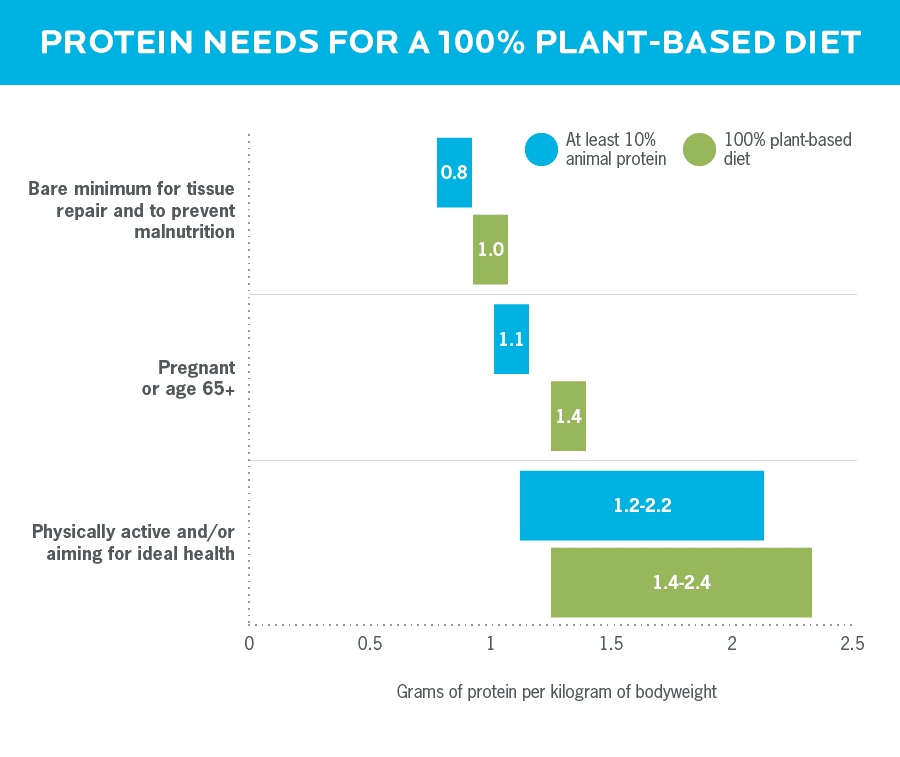
Which plant-based foods are high-protein?
Below, you’ll find a full plant-based protein foods list—as well as some vegetarian and pescatarian options.
But before we get to the list, a quick explanation of how we created it.
Here at Precision Nutrition, we don’t label foods “good” or “bad.” But some foods are more health-promoting than others. That’s why we look at foods on a spectrum from “eat more” to “eat some” to “eat less.”
We collaborated with our team of nutrition experts to categorize plant-based foods along a continuum, allowing for multiple perspectives and debate. We considered a variety of factors in creating the list you’ll see below, including:
- Health and nutrition data on a given food, including long-term health outcomes in people who have been eating it for a long time (if that information is available).
- Recommended daily intakes of various nutrients and how a given food helps fulfill those.
- Reward and palatability: how much these foods may or may not overstimulate your senses and override normal fullness cues.
- Nutrient density: meaning what macronutrients, micronutrients, phytonutrients, myconutrients, and zoonutrients a food contains.
- Level of processing, because more highly-processed foods are often (but not always!) less health-promoting.
Our intention wasn’t to create a perfect, undebatable list, but rather a practical tool to help plant-based eaters understand their options and progress toward health goals.
It’s also worth noting that there are exceptions everywhere.
For someone allergic to soy products, tempeh and tofu won’t be in the “eat more” category.
If a plant-based eater values environmental sustainability above all else, resource-intensive foods such as products derived from water-hungry nuts and certain types of fish will be placed in the “eat some” or “eat less” categories.
With that said, let’s get to our plant-based protein foods list.
By focusing on protein-rich foods in the “eat more” and “eat some” categories, you’ll be prioritizing lean, minimally-processed sources of protein. (But that doesn’t mean you can never have foods in the “eat less” category.)
And keep in mind that your own personal spectrum may look a bit different from what’s laid out in the sections that follow.
Protein sources
The following foods can be considered your primary source of protein in a meal. Depending on your approach to plant-based eating, you may want to stick with the sources in the fully plant-based section, or add options from the vegetarian and pescatarian sections, too.
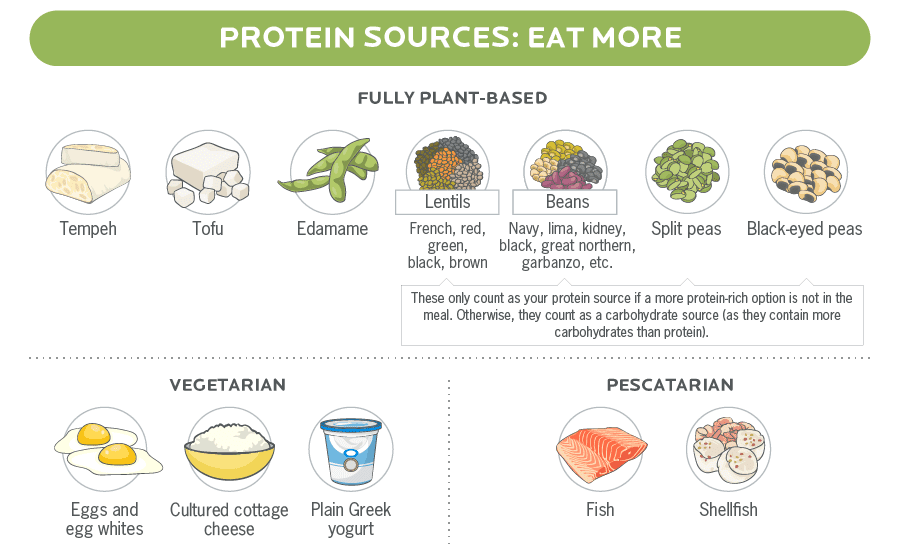
Fully plant-based
Soy products: Tofu, tempeh, and edamame are all high in protein and are present in a variety of dishes across various cultures.
Soy has been the subject of much controversy, but the body of research shows that in reasonable amounts, it’s overall safe. Research indicates that:
- Soy foods and isoflavone (bioactive compounds found in soy) supplements have no effect on testosterone in men.
- Soy doesn’t increase risk of breast cancer in women.
- Soy most likely doesn’t have a harmful effect on thyroid health, either, though more research is needed in this area (If you want to get the full story on soy, here’s more info.)
Lentils: Lentils are a type of legume that have a rich and nutty flavor. The most common varieties in North America are brown, green, and red, but there are many others that can be found worldwide. Lentils are highly nutritious: They contain generous amounts of protein, slow-digesting carbohydrates, and fiber.
Beans: There are many types of beans to choose from. For example: black, pinto, navy, lupini, cannellini, and more. Generally, beans are high in fiber and carbohydrates, and provide a moderate amount of protein.
Split peas: Those who have digestive issues with beans and legumes may find that split peas are less irritating.
Black-eyed peas: These offer a similar nutrition profile to beans and lentils.
Vegetarian
Eggs and egg whites: Chicken eggs are considered one of the world’s most versatile foods, and one of the best vegetarian protein sources. A single egg contains about 6.5 grams of protein, plus minerals like iron and folate, and a healthy dose of vitamins A, E, D, and B12.
There’s some debate over whether egg yolks are healthy or not. They won’t increase blood cholesterol or the risk of heart or artery disease—for most people. However, egg yolks should likely be minimized for people with diabetes, heart disease, and or familial hypercholesterolemia. For everyone else, they are a rich source of protein, vitamins, minerals and other health-promoting nutrients.
Plain Greek yogurt: Bacterially produced dairy products—or ones that are made with fermentation—seem to be the healthiest options. Most varieties of yogurt fall into this category, but Greek yogurt is particularly high in protein. (And in case you’re wondering, flavored Greek yogurt and other types of yogurt are considered sources of carbohydrates and/or fats, which happen to contain a little extra protein.)
Cultured cottage cheese: Similar to Greek yogurt, cottage cheese is a high-protein dairy option that can be particularly beneficial when made with live cultures. (The product label will note if it’s made with live and active cultures.)
Pescatarian
Fish: There are lots of choices within this category. Examples: cod, salmon, tilapia, herring, halibut, trout, snapper, and more. Fish is an ideal source of lean protein and is often rich in other nutrients, such as vitamin B12 and omega-3 fatty acids.
Shellfish: Scallops, shrimp, clams, oysters, crab, lobster, and mussels are high in protein and other nutrients, like omega-3 fatty acids, vitamin B12, and zinc. Some are rich in iodine, which is key for thyroid health.
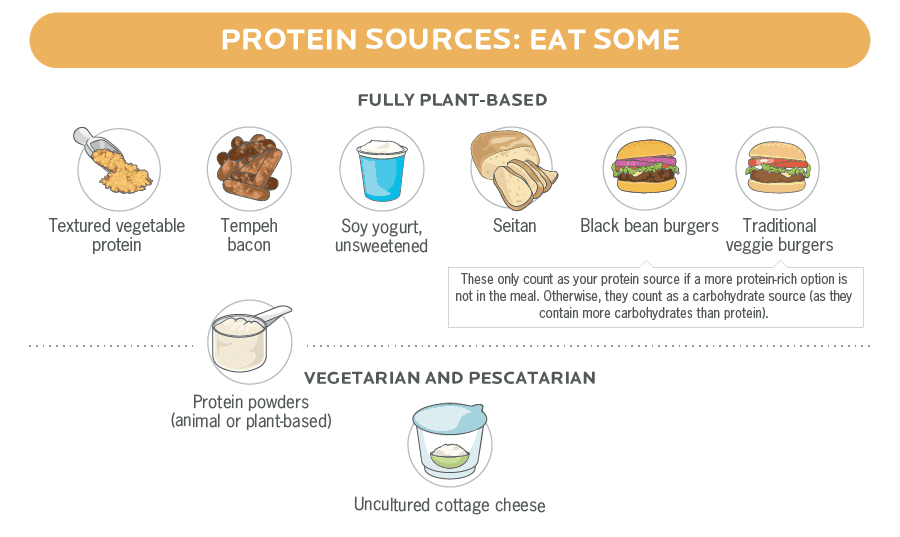
Fully plant-based
Plant-based protein powders: There are many types of plant-based protein powder on the market including soy, pea, rice, hemp, and other vegan blends. There are pros and cons to each type, so it’s best to choose based on your own individual preferences and needs.

If you choose to use protein powder, 20-40 grams of protein per day (usually 1-2 scoops) from protein powder is a reasonable amount. For most, 80 grams per day (about 3-4 scoops) is an upper limit of supplemental protein intake.
This isn’t a hard and fast rule, just a general guideline.
The main reason: Getting more than 80 grams from protein powder is excessive for most people, as it displaces whole food sources that are more filling and provide vitamins, minerals, and other nutrients. That’s why it’s in the “eat some” section.
Textured vegetable protein: Also known at TVP, this is a soy product that is derived from soy protein isolate, a processed version of the protein found in soybeans. It has a texture similar to ground meat, which makes it easy to add to sauces, soups, stews, curries, and more. It’s a dense source of high-quality protein, kind of a “food-like” equivalent of protein powder.
Tempeh bacon: Usually made from a combination of tempeh, soy sauce or tamari, and maple syrup or other sweeteners, tempeh bacon can be made at home or bought pre-made. Though it has many of the same benefits as plain tempeh, it falls into the “eat some” category because it contains added sugars and other ingredients.
Soy yogurt, unsweetened: There are many types of plant-based yogurt available, but the only one that has a meaningful amount of protein is soy yogurt. When it’s unflavored, it can serve as a protein source since it has a higher proportion of protein relative to carbohydrates and fat. Flavored soy yogurts and other plant-based yogurts can be considered primarily sources of carbohydrates and/or fats, since they’re usually higher in one of those two macronutrients than protein.
Seitan: This meat substitute is made from gluten, the protein found in wheat, which means it’s not suitable for people who are gluten free. Because seitan goes through a lot of processing and doesn’t offer much aside from protein in terms of nutrition, it’s not as good of an option as tofu and tempeh. Seitan does have a relatively meat-like texture, which makes it a popular meat substitute in restaurant dishes.
Black bean burgers and traditional veggie burgers: These can be a source of protein, but they’re often more diluted in terms of their protein content. Veggie burger ingredients vary widely across manufacturers, so like all other foods on this continuum, their position isn’t set in stone. Some include lots of vegetables and high-quality sources of protein, while others contain lots of additives and few other nutrients.
Vegetarian
Animal-based protein powders: Similar to plant-based protein powders, there are many varieties of animal-based protein powders. The highest quality protein powders in this category are dairy and egg-based. Similar to plant-based protein powders, limiting protein from animal-based protein powders to 20 to 40 grams per day (with an upper limit of 80 grams per day) is a good guideline.
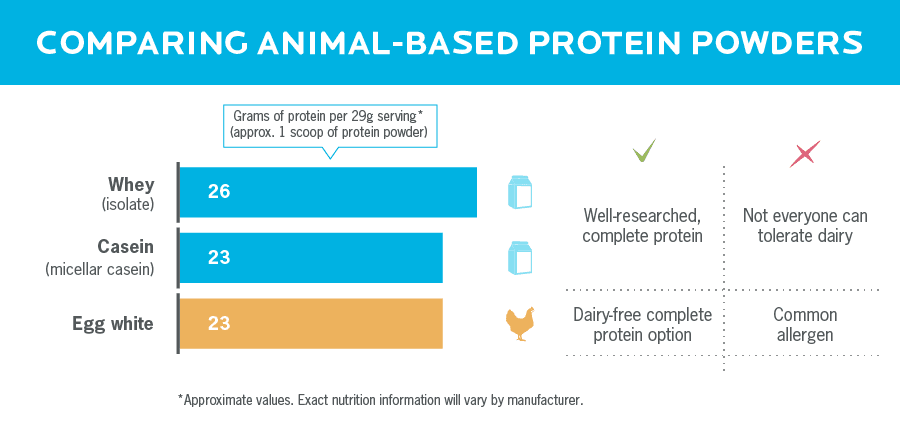
(To learn more about all types of protein powders, read this article.)
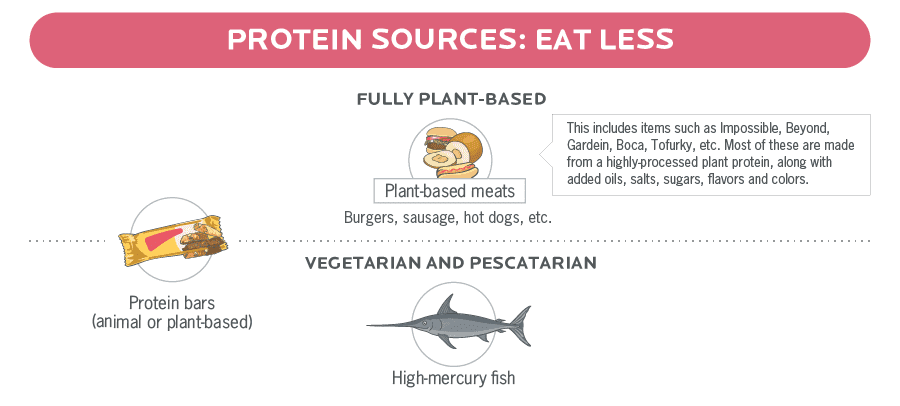
Fully plant-based
Plant-based protein bars: You can probably guess by now why plant-based protein bars fall under “eat less.” Even if a protein bar is a good source of protein, it’s likely to contain a host of other ingredients that have little to offer nutritionally. Protein bars may be convenient on the go, but there are a lot of other portable snack options to consider (including homemade protein bars, which can be made with any type of protein powder).
Plant-based meats: This category includes branded products and burgers like Impossible, Beyond, Gardein, Boca, and Tofurkey. People are often curious about why these products, particularly some of newer, more innovative ones, are in the “eat less” category.
One reason: Most plant-based meats are made from a highly-processed plant protein, along with added oils, salts, sugars, flavors, and colors. The more meat-like burger products are usually comparable to an 80-percent lean beef burger. That type of meat would also fall into the “eat less” category—something you might eat once in a while, but not every day if your goal is better health.
And in the case of some of the newer, highly-engineered products in this category, ingredients that are brand-new to the human food system are used to create a more meat-like result. We simply don’t know how these ingredients will impact long-term health. Of course, it’s possible we’ll eventually realize they’re not harmful at all. But we might also look back 20 years from now and say, “Wow, highly-processed plant-based meat wasn’t such a great idea after all!”
On the positive side, these products do help normalize plant-based eating. They’re increasingly available in restaurants, and can be an appealing alternative to less palatable plant-based options, especially in restaurants that don’t specialize in this type of cuisine.
Plant-based meat may also be helpful in cases where the plant-based eater might otherwise feel like an outsider. Allowing for a more inclusive eating experience.
Vegetarian
Animal-based protein bars: Similar to plant-based protein bars, these usually contain lots of extra ingredients that offer little, if any, additional health benefit.
Pescatarian
High-mercury fish: Eating fish is the major source of mercury exposure for humans. When mercury reaches a certain level in your body, it can cause serious health problems. Predatory fish like shark, albacore tuna, king mackerel, tilefish, swordfish and orange roughy have the highest levels of mercury.
Fish/seafood that aren’t predatory—including sardines, salmon, clams, and shrimp—have lower levels. What’s more, farmed fish generally have the lowest mercury content (though there may be other concerning outcomes with intensive fish farms).
Plant-based carbohydrates and fats that are high in protein
These foods can help boost your protein intake, but are primarily carbohydrates or fats. They’re especially helpful for 100 percent plant-based eaters in increasing protein intake.
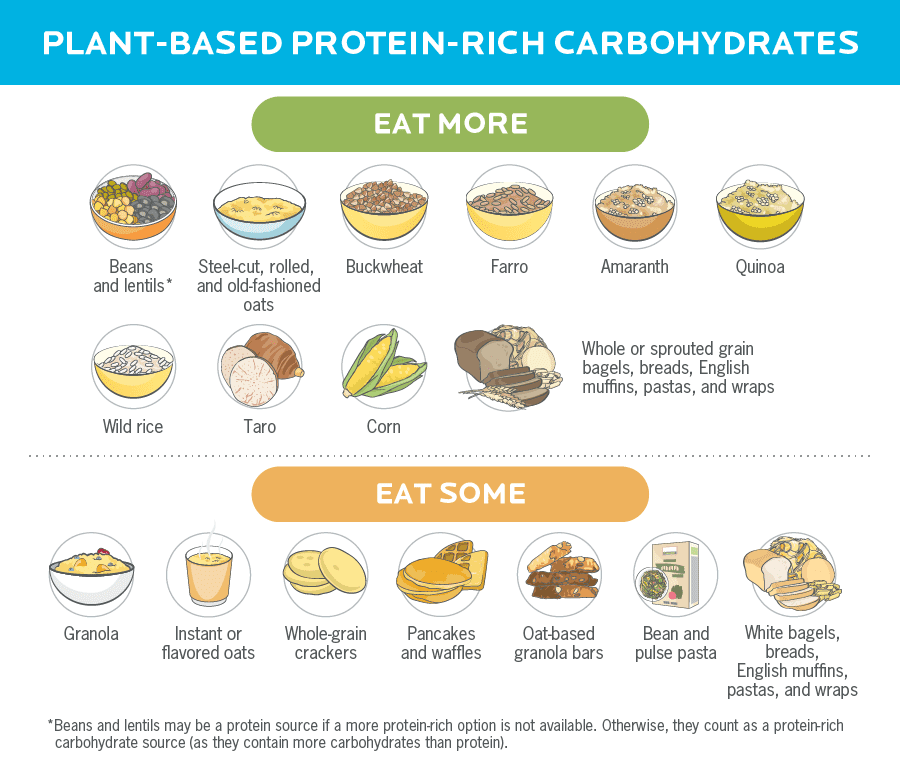
Protein-rich carbohydrates include foods like beans, lentils, and grains.
(As noted above, beans and lentils can count as a protein source if you don’t have another source of protein in your meal, but they are higher in carbohydrates than protein.)
Grains like buckwheat, farro, amaranth, quinoa, oats, and wild rice also fall into this category.

These fat sources boost protein intake and often add tasty flavor and other healthful nutrients, like omega-3 fatty acids, while they’re at it.
Various nuts and seeds, peanuts and peanut butter, and some plant milks fall into this category.
3 common plant-based protein problems, solved.
Problem #1: I’m supposed to be eating all these beans and legumes, but my stomach is a mess.
When you’re all-in on eating more plants, it can be easy to go overboard with beans and legumes. Black bean burrito for breakfast! Yellow dal for lunch! Chickpea stew for dinner! Yum!
But for some people, eating too many beans and legumes too quickly can cause digestive upset.
How to fix it:
Eat slowly. We talk about this a lot at Precision Nutrition, for good reason. Our digestion can be significantly affected by the pace of incoming food, how well we chew it, and the state of our nervous system. When we rush at a meal, we may activate our sympathetic nervous system, which induces the “fight or flight” response and can mess with digestion. By staying calm and eating slowly, we’re more likely to stay in the parasympathetic “rest and digest” state. (Read more: Your Complete Guide to Slow Eating.)
Add beans and legumes gradually, and try a variety. Beans and legumes are good for you—there’s no doubt about that. But they can cause gastrointestinal issues for some people because they contain fermentable fiber. Fermentable fiber is great for your gut and microbiome, but it does cause gas and other digestive problems in some people, particularly those who aren’t used to eating a lot of fiber.
It may help to add them into your diet slowly. Try a spoonful or two of cooked beans or legumes each day, and see how well your GI tract tolerates them. Give your body time to adjust. If things seem okay, add quantity over time.
Also, experiment with different types of beans and legumes. You may find, for instance, that chickpeas are okay, but black beans aren’t.
Consider preparation. Beans and legumes prepared in certain ways may be better tolerated. For example, canned beans and legumes might be easier on your stomach than those prepared from dry. (Just make sure to rinse them before eating!)
If you prepare them from dry at home, make sure to rinse, soak, and cook them well. Not only are undercooked beans and legumes hard to eat and digest, some types of raw, dry beans can be actively toxic. For instance, dry red kidney beans contain a lectin (a type of protein) called phytohaemagglutinin, which can poison us with as few as four or five beans.
Try digestive enzymes. Alpha-galactosidase is an enzyme that helps to break down the bloat-inducing starch in beans. This isn’t a cure-all, but taking this digestive enzyme as a supplement helps some people find relief.
Problem #2: I’m having trouble meeting my protein goals.
Especially if you’re new to plant-forward eating, it may feel difficult to meet protein goals. This can be particularly challenging if you have limited food options because of allergies, intolerances, food aversions, budget constraints, or gastrointestinal problems, such as IBS and IBD.
How to fix it:
Eat a variety of foods. Expanding your protein options can make it a lot easier to hit your protein goals. Review the list of plant-based protein sources and jot down a few new ones to try. Eating a variety of protein sources also means you’ll get an array of amino acids, which as we covered earlier, is key.
Try a protein powder. Some people find the convenience and portability of protein powders to be really helpful in meeting their protein goals. Protein powder shouldn’t be your only source of protein, but it can provide a boost. (Learn more about how to fit protein powder into your diet here.)
Consider including animal protein strategically. If you’re open to it, adding some animal protein—whether from dairy, fish, or meat—may be helpful if eating only plant-based protein isn’t cutting it.
Zoom out. It’s okay to have days of eating lower amounts of protein. The human body allows for some wiggle room. In other words, we can probably meet our basic protein needs over a number of days.
Think about it: You don’t suffer protein malnutrition if you choose to eat french fries for dinner, go to bed, and don’t eat any protein again until the next day. So if you’re low on protein some days and high on protein others, don’t sweat it. It’s your pattern of protein intake over time that really matters.
Problem #3: I’ve got a list of plant-based protein sources, but I don’t know how to eat/cook them.
If you’re not used to eating a plant-based diet, it can feel daunting to figure out how to create a meal around plant-based proteins. After all, a list of protein sources can only take you so far if they feel completely unfamiliar.
For some, not knowing how to incorporate plant-based proteins becomes a barrier to trying a plant-based diet in the first place.
How to fix it:
Remember that plant-based eating exists on a spectrum. You don’t have to eat only plant-based protein to reap the benefits of a plant-based diet (unless you want to). Plenty of plant-based eaters include dairy, fish, and even meat in their diet regularly or occasionally. So remind yourself that there are lots of ways to be a plant-based eater, depending on your reasons.
Focusing on what you can add to your diet rather than what you “have to” take away can be a helpful mindset shift. If you’re not ready to remove animal products from your diet completely, you can make your favorite chicken pasta dish and add some chickpeas to it.
“Plantify” your go-to meals. One way to find inspiration is to take some of your favorite meals and swap some animal ingredients for plant-based ones. For example, if you love beef burritos, you could try making tempeh burritos instead. Or just trade the cheese for avocado. Or mix in some seitan with the beef. If you always order pad thai with chicken, try it with tofu.
As you experiment with different combinations, keep a running list of plant-based protein recipes you enjoyed. Categorize your list by breakfasts, lunches, and dinners so you can refer back to it when you’re looking for meal ideas.
Map out meals ahead of time. Not everyone loves meal prepping. That’s okay. But if you’re open to it, planning and cooking your meals in batches is a great way to ensure you get plant-based protein into each meal.
Plus, having meals ready ahead of time helps banish decision fatigue about food. Since we make so many decisions on a day-to-day basis, it’s nice to not have to worry in the moment whether or not your meals have enough protein.
There are lots of ways to win the plant-based protein game.
Just like there’s no single best diet for everyone, there’s no best way to be a plant-based eater.
Including more plant foods in our diets can offer benefits that extend from personal (reducing the risk of chronic disease) to planetary (creating less of an ecological burden).
Still, many of us face a daily nutritional contradiction. On the one hand, we have protein in our nutritional bullseye. And on the other, we aren’t quite sure how—or if—plant foods can contribute to our daily protein requirements.
But whether you’re avoiding animal products completely, or just want to get some more plant goodness into your diet, plant-based protein will play an important role in your diet.
At first, it may feel daunting to figure out how much protein you need and how to get enough of it. But like anything else, with the right tools, a little bit of practice, and openness to experimentation, you’ll be a plant-based protein pro in no time.
References
Click here to view the information sources referenced in this article.
If you’re a coach, or you want to be…
You can help people build sustainable nutrition and lifestyle habits that will significantly improve their physical and mental health—while you make a great living doing what you love. We'll show you how.
If you’d like to learn more, consider the PN Level 1 Nutrition Coaching Certification. (You can enroll now at a big discount.)



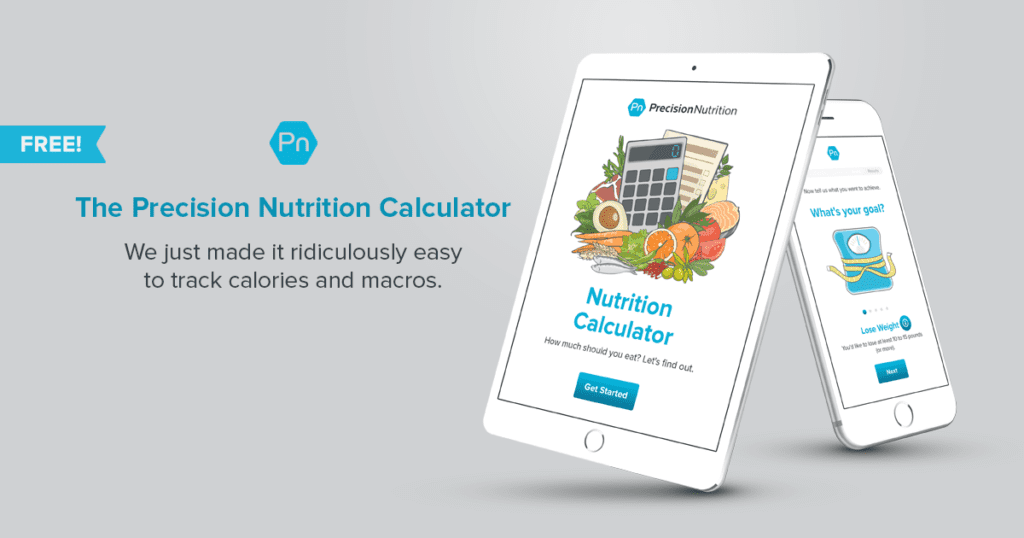
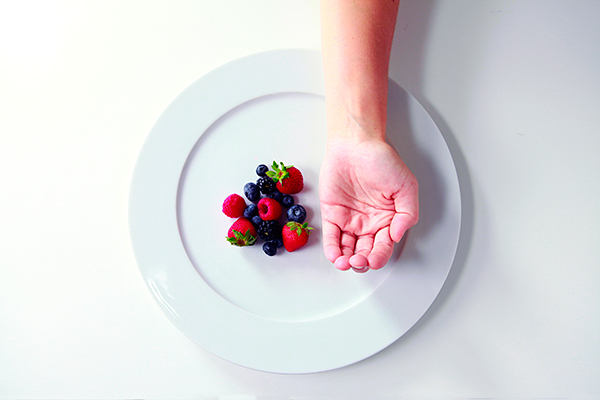
Share